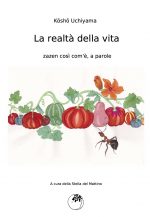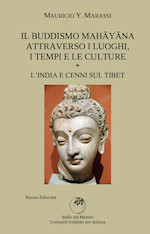Words are not colours
The first sentence of Shōji reads: “Shōji no naka ni hotoke areba shōji nashi. Mata iwaku, shōji no nakani hotoke nakereba shōji ni madowazu”(5). A little down the page we find: “Tada shōji sunawachi nehan to kokoroete”(6). We translate the first phrase as follows: “When there is Buddha in life-and-death, there is no life and no death”. And, later, “When Buddha is not in (our) life-and-death, we cannot be fooled about life and death”. Let’s translate also the second sentence: “Understand life-and-death with the utmost clarity: it is our nirvāņa”.
Almost all the key sentences in this work of Dōgen’s remind one of some crucial statements in Nāgārjuna’s Mūlamadhyamakakārikā, Fundamental Verses on the Middle Way.
The sentences I have chosen to translate, however, in addition to being found in the work of the Indian patriarch, and therefore, clearly in the line of the true Buddhism, as I called it above, display another very unusual feature.
Shōji is the Japanese reading for the ideograms of one of the three Chinese translations of the Sanskrit term samsāra(7). It is a very interesting translation because it does not render the word samsāra literally, but instead it transmits its inner dynamic meaning; a meaning that is rooted in the experience of our own life. It describes the cycle of life – birth, life and death – when it is devoid of any clarity, when it is utterly bewildering even in regard to what is happening to us at the very moment it is happening, let alone in regard to their meaning. When we are at the mercy of events, tangled up and made impenetrable by our pursuit of our desires, birth-life-death is samsāra.
As he says himself, Dōgen pulls out the first sentence of a story contained in the Jingde chuangden lu(8). But in that work, the two propositions that make up this sentence taken literally have a meaning diametrically opposed to Dōgen’s. In fact, they say: “If Buddha is absent from life-and-death, there is no life and no death” and “Buddha in life-and-death implies not fooling oneself about life and death”.
We will show how these two statements seem opposite and are instead equivalent. But first, I want to stress here that what unites them is the pratītyasamutpāda(9). I am thinking in particular of the following sentences, written by Nāgārjuna in Mūlamadhyamakakārikā 22.16: “The intimate nature of the Tathāgata [one of Buddha’s names] is the intimate nature (essence) of this world. But the Tathāgata has no intimate nature (essence): devoid of intimate nature (empty of essence) is this world”.
The solution of the strange problem in which words are “true” (or, anyway, have the same meaning) both when they affirm and when they deny the same “thing” is similar to the solution to the mathematical question implicit in the demonstration that one is equal to two(10). Anybody who has a smattering of mathematics can debunk this demonstration: it is enough to recall the rule that forbids dividing by zero. But we are not talking mathematics, and therefore we need not apply this rule.
Foot notes:
5) 生死 の 中に 佛あれば 生死なし。又云く、生死の 中に 佛なければ 生死に まどわず.
6) ただ 生死すなわち 涅槃とこころえて.
7) Literally “samśāra” means “circle” (sam) and “turn around” (sar). The literal translation in Chinese is lunhui (輪廻), which is pronounced rinne in Japanese.
8) Jingde [era] record of the transmission of the lamp/light, better known under its Japanese title, Keitoku Dentōroku. Written in 1004 by a monk of the Fayan (Japanese Hōgen) school, one of the Chan lineages, it contains aphorisms and short stories about the lives of 1700 Chan monks.
9) Usually translated as “interdependent generation” or “conditional coproduction”. Literally, pratītya means “going towards” “as a function of” and samutpāda “mutual origination”, “sprouting together”.
10) 1=A=B. Thus: A2=AB. It follows that: A2-B2=AB-B2. Decomposing: (A-B)(A+B)=B(A-B). Simplifying: A+B=B which means that 2=1. But the simplification is wrong because A-B=0.
Se volete, lasciate un commento.
You must be logged in to post a comment.







